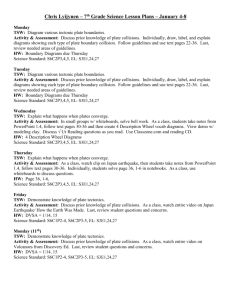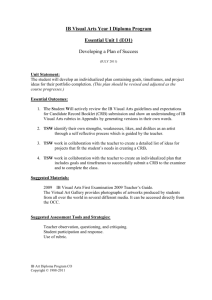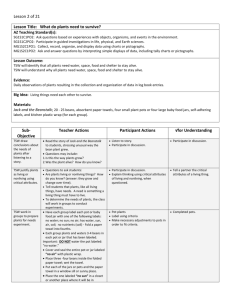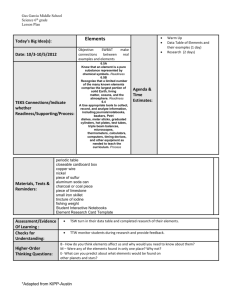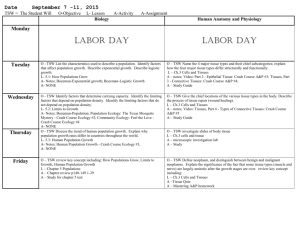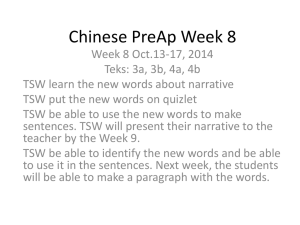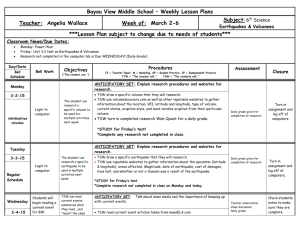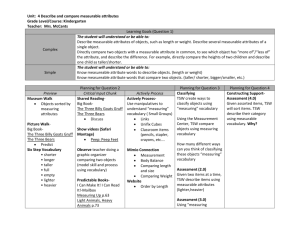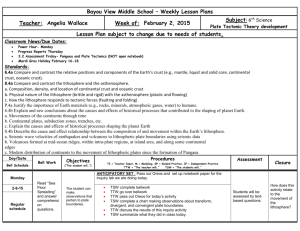12-13 EARTH SCI E04 11
advertisement
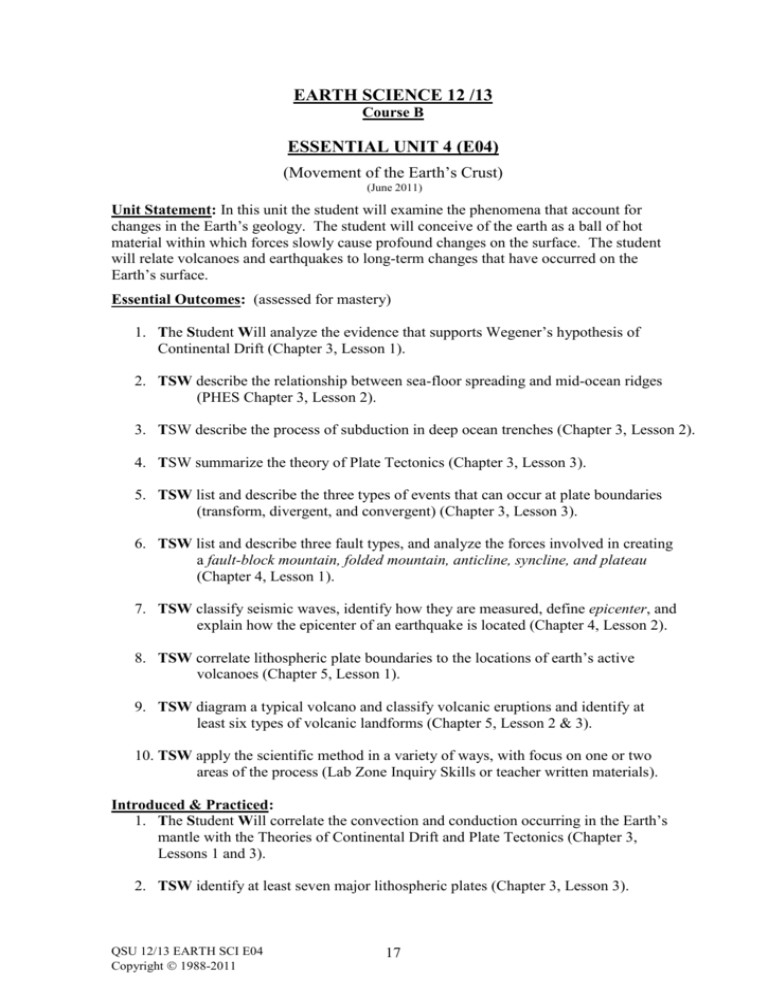
EARTH SCIENCE 12 /13 Course B ESSENTIAL UNIT 4 (E04) (Movement of the Earth’s Crust) (June 2011) Unit Statement: In this unit the student will examine the phenomena that account for changes in the Earth’s geology. The student will conceive of the earth as a ball of hot material within which forces slowly cause profound changes on the surface. The student will relate volcanoes and earthquakes to long-term changes that have occurred on the Earth’s surface. Essential Outcomes: (assessed for mastery) 1. The Student Will analyze the evidence that supports Wegener’s hypothesis of Continental Drift (Chapter 3, Lesson 1). 2. TSW describe the relationship between sea-floor spreading and mid-ocean ridges (PHES Chapter 3, Lesson 2). 3. TSW describe the process of subduction in deep ocean trenches (Chapter 3, Lesson 2). 4. TSW summarize the theory of Plate Tectonics (Chapter 3, Lesson 3). 5. TSW list and describe the three types of events that can occur at plate boundaries (transform, divergent, and convergent) (Chapter 3, Lesson 3). 6. TSW list and describe three fault types, and analyze the forces involved in creating a fault-block mountain, folded mountain, anticline, syncline, and plateau (Chapter 4, Lesson 1). 7. TSW classify seismic waves, identify how they are measured, define epicenter, and explain how the epicenter of an earthquake is located (Chapter 4, Lesson 2). 8. TSW correlate lithospheric plate boundaries to the locations of earth’s active volcanoes (Chapter 5, Lesson 1). 9. TSW diagram a typical volcano and classify volcanic eruptions and identify at least six types of volcanic landforms (Chapter 5, Lesson 2 & 3). 10. TSW apply the scientific method in a variety of ways, with focus on one or two areas of the process (Lab Zone Inquiry Skills or teacher written materials). Introduced & Practiced: 1. The Student Will correlate the convection and conduction occurring in the Earth’s mantle with the Theories of Continental Drift and Plate Tectonics (Chapter 3, Lessons 1 and 3). 2. TSW identify at least seven major lithospheric plates (Chapter 3, Lesson 3). QSU 12/13 EARTH SCI E04 Copyright 1988-2011 17 3. TSW compare three scales (Mercalli, Richter, and Moment Magnitude) used to measure the severity of earthquakes (Chapter 4, Lesson 2). 4. TSW demonstrate how a seismograph works (Chapter 4, Lesson 3). 5. TSW explain how to protect him/herself during an earthquake (Chapter 4, Lesson 2). 6. TSW summarize the evidence for volcanoes elsewhere in the solar system (resource of your choice). Key Terms: continental drift Pangaea fossil mid-ocean ridge sea-floor spreading deep-ocean trench subduction plate divergent boundary convergent boundary transform boundary fault rift valley stress tension compression shearing plateau earthquake focus epicenter P wave S wave surface wave seismograph magnitude Richter scale seismogram volcano magma lava SUGGESTED RESOURCES & RUBRIC FOUND ON FOLLOWING PAGES………. QSU 12/13 EARTH SCI E04 Copyright 1988-2011 18 Ring of Fire hot spot pipe vent lava flow crater silica pyroclastic flow dormant extinct caldera cinder cone shield volcano volcanic neck dike sill Suggested Materials: Interactive Science – Earth’s Structure – Chapters 3, 4, and 5 Suggested Unit Resources: 1. Lab Zone; fully editable CD-Rom; Chapter Lab Investigations, Inquiry Warm-Ups, and Quick Labs (refer to Interactive Science – Earth’s Structure, page viii, ix, and x for a specific list of labs available for this unit). 2. Lab Zone Inquiry skills for each lesson as suggested in Interactive Science – Earth’s Structure, Contents, page viii, ix, and x). 3. Study Guide & Review and Assessment for Interactive Science – Earth’s Structure Chapters 3, 4, and 5. 4. Untamed Science Video Series 5. Other ancillary materials, if available. Technology Resources: 1. http://www.myscienceonline.com activities; The Big Question, Vocab Flash Cards, Interactive Art, Planet Diary, Virtual Lab, Untamed Science, My Science Coach, and My Reading Web. Use keywords ‘Plate Tectonics,’ ‘Earthquakes,’ and ‘Volcanoes.’ 2. The Library’s online database – Destiny Webpath Express 3. http://www.unitedstreaming.com if your school has a membership. 4. http://www.iris.edu/seismon/ 5. http://earthquake.usgs.gov/earthquakes/recenteqsww/Quakes/quakes_all.html 6. Locate and epicenter activity http://www.aktsunami.com/lessons/5- 8/unit3/5-8_16LocatingTheEpicenter.pdf Suggested Assessment Tools and Strategies: 1. Students make a three-dimensional model to explain continental drift and plate tectonics (TSW 1-4). 2. Students keep a journal of observations, ideas, and findings reflecting on reading, experiments, and class discussions (TSWs 1 - 10). 3. Students produce a ‘flipbook’ or animated video showing continental drift, heat transfer within the Earth, and/or local seismic events (TSWs 1 - 10). 4. Students create a model of different types of faults and simulate earthquakes (TSW’s 5 -7). 5. Students chart recent earthquakes and major volcanic eruptions on a world map (TSWs 5-10). 6. Students write a report, create a poster, and/or give a class presentation on any of the relevant topics (TSWs 1 - 10). 7. Students draw or make models of different types of volcanic landforms (TSW 10). 8. Teacher generated and/or published tests and assessments (TSWs 1 - 10). RUBRIC FOUND ON FOLLOWING PAGE……………………… QSU 12/13 EARTH SCI E04 Copyright 1988-2011 19 TSW 1 – Continental Drift Suggested Rubric for E04 ‘A’ Level Mastery ‘B’ Level Mastery Student is able to explain the evidence that supports Wegener’s theory of continental drift and describe its shortcomings. 2 – Sea floor spreading The student is able to connect this information with what Wegener was missing in his theory. The student is able to describe how sea floor spreading causes mid-ocean ridges. 3 – Subduction and deep ocean trenches The student is able to describe the effects of subduction on land and how it and sea floor spreading changes the size of the oceans. The student is able to describe the process of subduction. 4 – Plate tectonics The student is able to analyze the forces at work in plate tectonics regarding convection, mountain ranges forming, earthquakes, volcanic activity and continents moving as well as find examples to illustrate each. The student is able to explain the theory of plate tectonics. 5 – Plate boundaries The student is able to illustrate the three types of plate boundaries and label the direction of movement in each. 6 – Fault lines The student creates models of faults that simulate the forces at work to create folding, anticlines, sinclines and fault block mountains. The student will describe the three types of faults as well as folding, anticlines, sinclines and fault block mountains. 7 – Earthquakes and seismic waves The student is able to differentiate between the forces at work in different types of seismic waves and explain why they travel at different velocities. The student is able to explain what causes earthquakes, classify earthquake waves, and define epicenter. 8 – Volcanic activity The student will illustrate and explain the reasons for the volcanic acitivity occurring recently on a world map. 9 – Types of volcanoes The student is able to connect magma composition with the volatility of an eruption. 10 – Scientific Method The student is able to analyze results, The student responds to Lab Zone Inquiry evaluate the validity of data, and pose Skills or teacher designed activities with additional questions and hypotheses reasonable responses. based on conclusions of an experiment. The student is able to diagram a volcano and classify the different types of volcanic eruptions. The student is able to define six types of volcanic landforms. To receive an ‘A’, the student must show ‘A’ level mastery in at least 4 of the 6 available TSW’s and ‘B’ level mastery on all of the remaining TSW’s. To receive a ‘B’, the student must show ‘B’ level mastery on all ten TSW’s. QSU 12/13 EARTH SCI E04 Copyright 1988-2011 20

